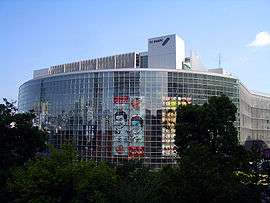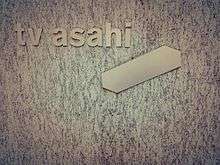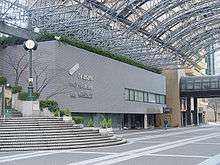TV Asahi
TV Asahi Corporation (株式会社テレビ朝日, Kabushiki-gaisha Terebi Asahi), also known as EX and Tele-Asa (テレ朝, Tere Asa), is a Japanese television network with its headquarters in Roppongi, Minato, Tokyo, Japan. The company also owns All-Nippon News Network.
 TV Asahi logo since 2003 | |
 TV Asahi headquarters in Roppongi, Minato, Tokyo since 2003 | |
Native name | 株式会社テレビ朝日ホールディングス |
|---|---|
Romanized name | Kabushiki-gaisha Terebi Asahi Hōrudingusu |
Formerly | Nihon Educational Television Co., Ltd. Asahi National Broadcasting Co. Ltd. |
| Public | |
| Traded as | TYO: 9409 |
| ISIN | JP3429000007 |
| Industry | Information, Communication |
| Founded | Tokyo, Japan (November 1, 1957) |
| Headquarters | 9-1, Roppongi Rokuchome, Minato, Tokyo, Japan |
Key people |
|
| Products | Broadcasting, TV program production, etc. |
| Services | Stockholding |
| Revenue | |
| Total assets | |
| Total equity | |
| Owner | The Asahi Shimbun Company (24.72%) Toei (16.09%) Murayama family (co-owner of Asahi Shimbun; 5% through Kosetsu Museum of Art) Mizuho Trust & Banking (4.01% through Trust & Custody Services Bank) Kyushu Asahi Broadcasting (3.2%) Recruit (2.09%) State Street BTC of Japan (2.02%) The Asahi Shimbun Foundation (2%) Northern Trust (1.92%) The Master Trust Bank of Japan (1.77%) |
Number of employees | 1,148 (as of June 30, 2011) |
| Parent | Asahi Shimbun (24.83%) |
| Subsidiaries | TV Asahi Corporation CS 110 Co., Ltd. Flex Co., Ltd. Japan Cable Television Shin-Ei Animation TV Asahi America Inc. TV Asahi Music Co., Ltd. TV Asahi Productions, Co., Ltd. TV Asahi Service Co., Ltd. Video Pack Nippon JTBC New Japan Pro-Wrestling (10%) |
| Website | www |
 | |
Native name | 株式会社テレビ朝日 |
|---|---|
Romanized name | Kabushiki-gaisha Terebi Asahi |
| Kabushiki gaisha | |
| Industry | Information, Communication |
| Founded | Tokyo, Japan (October 15, 2013) |
| Headquarters | 9-1, Roppongi Rokuchome, Minato, Tokyo, Japan |
Key people |
|
| Products | Broadcasting, TV program production, etc. |
| Services | Telecasting, Program producing |
| Revenue | |
| Total assets | |
Number of employees | 4,021 (as of March 31, 2014) |
| Parent | TV Asahi Holdings Corporation |
| Subsidiaries | TV Asahi ASK Co., Ltd. Shinei Video TV Asahi Video Co., Ltd. NJPW World |
| Website | tv-asahihd |
Headquarters

In 2003, the company headquarters moved to a new building designed by Fumihiko Maki at: 6-9-1 Roppongi, Minato, Tokyo, Japan.
Some of TV Asahi's departments and subsidiaries, such as TV Asahi Productions and Take Systems, are still located at TV Asahi Center, the company's former headquarters of 1986–2003. It is located at Ark Hills, not far from its headquarters.

History

TV Asahi began as "Nihon Educational Television Co., Ltd." (NET) (株式会社日本教育テレビ, Kabushiki-gaisha Nihon Kyōiku Terebi, "The Japanese Educational Television Company") on November 1, 1957. It was established as a for-profit educational television channel. At the time, its broadcasting license dictated that the network is required to devote at least 50% of its airtime to educational programming, and at least 30% of its airtime to children's educational programming. The station was owned by Asahi Shimbun, Toei Company, Nihon Keizai Shimbun, and Obunsha.
However, the for-profit educational television model eventually proved to be a failure. In 1960, NET began its transformation into a general-purpose television station. It began to broadcast anime and foreign movies. So as not to run afoul of the educational TV license requirements, NET justified the airing of these programs under the pretext of "nurturing a child's emotional range" (子供の情操教育のため, Kodomo no jōsō kyōiku no tame) and "introduction of foreign cultures" (外国文化の紹介, Gaikoku bunka no shōkai). At the same time, NET also changed its common name from "Nihon Educational Television" to "NET TV" (NETテレビ).
Seven years later, in 1967, NET aired its first colour broadcast programme. Part of its transformation into a general TV channel would be the April 1971 premiere of the Kamen Rider Series by the Toei Company and creator Shotaro Ishinomori, the tokusatsu superhero series that would make the channel a national hit. It has been its home ever since, joined by yet another toku series, Super Sentai, in the spring of 1975 (KR left the channel in 1975, only to return in 2000). Aside from these two live action programs, which would become part of its flagship programming, due in part by the work done by Toei's animation branch, the 70s were also marked on NET with great animation classics of national fame, which aired one after the other in the channel and were even exported to other countries, many of these would be part of daily life and culture and helped introduce the world to the anime genre. Such animations put the channel in direct competition with other stations which broadcast similar programming.
NET's transformation into a general-purpose television station was complete by November 1973, when NET, along with educational channel "Tokyo Channel 12" (now TV Tokyo) in Tokyo applied and received a general purpose television station license. At the same time, NET renamed itself as NET General Television (総合局NET), which subsequently became the "Asahi National Broadcasting Company, Limited" (全国朝日放送株式会社, Zenkoku Asahi Hōsō Kabushiki-gaisha, commonly named "TV Asahi") on April 1, 1977. Five years later, TV Asahi became the official network, until 1999, for yet another Toei live action franchise, the Metal Hero Series.
In 1996, TV Asahi established the All-Nippon News Network (ANN) (オールニッポンニュース・ネットワーク, Ōru Nippon Nyūsu Nettowāku), and began a number of reforms, including the unification of all presentation styles on its regional networks and the creation of a new logo to give Asahi the look and feel of a national television network. On October 1, 2003, TV Asahi moved its head office from its Ark Hills Studio to Roppongi Hills, and the station was renamed "TV Asahi Corporation", with the name presented as "tv asahi" on-screen.
The transmission of international aquatics competitions, World Cup football matches, and creation of popular late-night TV programs contributed to a rise in ratings for TV Asahi, and lifted the TV station from its popularly ridiculed "perpetual fourth place" finish into second place, right behind Fuji TV, by 2005.
The station also launched its own mascot, Gō EX Panda (ゴーエクスパンダ, Gō Ekkusu Panda), also known as Gō-chan (ゴーちゃん。) Gō-chan is currently seen on TV Asahi's opening sign-on ID.
Branding
TV Asahi's current branding were created by UK design collective Tomato (some members work as the electronic music group Underworld) along with TV Asahi's in-house design department in 2003. It comprises a set of computer-generated "sticks" in white background, which changes in colour and movement along with the background music that accompanies the idents. TV Asahi also uses a brief eyecatch of its sticks animation at the top-left of the screen after commercial breaks. The background music used for TV Asahi's sign-on and sign-off videos are Underworld's Born Slippy .NUXX 2003 and Rez. TV Asahi later updated its sign-on and sign-off video in 2008 with a revised version of computer-generated "sticks" animation and new background music. TV Asahi's slogan New Air, On Air appears at the top of its name. It can be seen on TV Asahi's YouTube channel, which in 2011-12, was replaced by its mascot, Go-Chan.
The company writes its name in lower-case letters, tv asahi, in its logo and public-image materials. Normally, the station branding on-screen appears as either "/tv asahi" or "tv asahi\". The station's watermark appearance is the stick at the top with the station's name at the bottom. The fonts used by TV Asahi for the written parts are Akzidenz Grotesk Bold (English) and Hiragino Kaku Gothic W8 (Japanese).[1]
TV broadcasting
Since 2004, the funding of this station is through sponsorship.
 | |
| Kantō Region, Japan | |
|---|---|
| Channels | Digital: JOEX-DTV, Channel 24 (UHF – LCN 5) |
| Branding | tv asahi テレビ朝日 EX |
| Slogan | New Air, On Air. (2008-present) |
| Programming | |
| Affiliations | All-Nippon News Network |
| Ownership | |
| Owner | TV Asahi Corporation |
| Sister stations | BS Asahi Tele Asa Channel 1 Tele Asa Channel 2 Zee Asahi |
| History | |
| Founded | 1957 |
| First air date | November 1, 1957 |
| Former channel number(s) | ch.# 10 (analog, 1957-2011), ch. #5 (digital) |
| Call sign meaning | JOEX = Japan'sOriginal Free-to-Air Educational TV Station X (10, former channel assignment) |
| Technical information | |
| ERP | 10 kW (68 kW ERP) |
| Transmitter coordinates | 35°39′31″N 139°44′44″E |
| Translator(s) | Hachiōji, Tokyo Analog: Channel 45 Tama, Tokyo Analog: Channel 60 |
| Links | |
| Website | http://www.tv-asahi.co.jp/ |
Analog
(until July 24, 2011 only for 44 out of 47 prefectures)
JOEX-TV – TV Asahi Analog Television (テレビ朝日アナログテレビジョン)
- Tokyo Tower – VHF Channel 10
- Tokyo
- Hachiōji – Channel 45
- Tama – Channel 57
- Islands in Tokyo
- Chichijima – Channel 59
- Ibaraki Prefecture
- Mito – Channel 36
- Hitachi – Channel 60
- Tochigi Prefecture
- Utsunomiya – Channel 41
- Gunma Prefecture
- Maebashi – Channel 60
- Saitama Prefecture
- Chichibu – Channel 38
- Chiba Prefecture
- Narita – Channel 59
- Tateyama – Channel 60
- Kanagawa Prefecture
- Yokohama-minato – Channel 60
- Yokosuka-Kurihama – Channel 35
- Hiratsuka – Channel 41
- Okinawa Prefecture
- Kita-Daito – Channel 48
- Minami-Daito – Channel 60
Digital
JOEX-DTV – TV Asahi Digital Television (テレビ朝日デジタルテレビジョン)
- Remote controller ID 5
- Tokyo Sky Tree – UHF Channel 24
- Ibaraki Prefecture
- Mito – Channel 17
- Tochigi Prefecture
- Utsunomiya – Channel 17
- Gunma Prefecture
- Maebashi – Channel 43
- Kanagawa Prefecture
- Hiratsuka – Channel 24
Networks
- Asahi Broadcasting Corporation, Analog Channel 6, Digital Channel 15 [ID: 6] - Headquartered in Osaka, broadcasts in the Kansai area
- Nagoya Broadcasting Network, Analog Channel 11, Digital Channel 22 [ID: 6] - Headquartered in Nagoya, broadcasts in the Chukyo area
- Hokkaido Television Broadcasting, Analog Channel 35, Digital Channel 23 [ID: 6] - Headquartered in Sapporo, broadcast in Hokkaidō
- Asahi Broadcasting Aomori, Analog Channel 34, Digital Channel 32 [ID: 5] - Headquartered in Aomori, broadcast in Aomori Prefecture
- Iwate Asahi Television, Analog Channel 31, Digital Channel 22 [ID: 5] - Headquartered in Morioka, broadcast in Iwate Prefecture
- Higashinippon Broadcasting, Analog Channel 32, Digital Channel 28 [ID: 5] - Headquartered in Sendai, broadcast in Miyagi Prefecture
- Akita Asahi Broadcasting, Analog Channel 31, Digital Channel 29 [ID: 5] - Headquartered in Akita, broadcast in Akita Prefecture
- Yamagata Television System, Analog Channel 38, Digital Channel 18 [ID: 5] - Headquartered in Yamagata, broadcast in Yamagata Prefecture
- Fukushima Broadcasting, Analog Channel 35, Digital Channel 29 [ID: 5] - Headquartered in Kōriyama, broadcast in Fukushima Prefecture
- The Niigata Television Network 21, Analog Channel 21, Digital Channel 23 [ID: 5] - Headquartered in Niigata, broadcast in Niigata Prefecture
- Hokuriku Asahi Broadcasting, Analog Channel 25, Digital Channel 23 [ID: 5] - Headquartered in Kanazawa, broadcast in Ishikawa Prefecture
- Asahi Broadcasting Nagano, Analog Channel 20, Digital Channel 18 [ID: 5] - Headquartered in Nagano, broadcast in Nagano Prefecture
- Shizuoka Asahi Television, Analog Channel 33, Digital Channel 18 [ID: 5] - Headquartered in Shizuoka, broadcast in Shizuoka Prefecture
- Hiroshima Home TV, Analog Channel 35, Digital Channel 22 [ID: 5] - Headquartered in Hiroshima, broadcast in Hiroshima Prefecture
- Yamaguchi Asahi Broadcasting, Analog Channel 28, Digital Channel 26 - Headquartered in Yamaguchi, broadcast in Yamaguchi Prefecture
- Setonaikai Broadcasting, Analog Channel 25, Digital Channel 30 - Headquartered in Takamatsu, broadcast in Kagawa and Okayama Prefectures
- Ehime Asahi Television, Analog Channel 25, Digital Channel 17 [ID:5] - Headquartered in Matsuyama, broadcast in Ehime Prefecture
- Kyushu Asahi Broadcasting, Analog Channel 1, Digital Channel 31 [ID: 1] - Headquartered in Fukuoka, broadcast in Fukuoka and Saga Prefectures
- Nagasaki Culture Telecasting, Analog Channel 27, Digital Channel 19 [ID: 5] - Headquartered in Nagasaki, broadcast in Nagasaki Prefecture
- Kumamoto Asahi Broadcasting, Analog Channel 16, Digital Channel 49 [ID: 5] - Headquartered in Kumamoto, broadcast in Kumamoto Prefecture
- Oita Asahi Broadcasting, Analog Channel 24, Digital Channel 32 [ID: 5] - Headquartered in Ōita, broadcast in Ōita Prefecture
- Kagoshima Broadcasting Corporation, Analog Channel 32, Digital Channel 36 [ID: 5] - Headquartered in Kagoshima, broadcast in Kagoshima Prefecture
- Ryukyu Asahi Broadcasting, Analog Channel 28, Digital Channel 16 [ID: 5] - Headquartered in Naha, broadcast in Okinawa Prefecture
Programs
Anime programs
- Area 88
- Ashita no Nadja (a.k.a. Nadja of Tomorrow)
- Atashin'chi
- Bobobo-bo Bo-bobo
- Battle Spirits Saikyou Ginga Ultimate Zero
- Battle Spirits: Heroes
- Brave series (Brave Exkaiser to GaoGaiGar, but not GaoGaiGar Final)
- Captain Harlock
- Cyborg 009 (1968 & 1979 series)
- Crayon Shin-chan
- Cutey Honey (the 1973 series and Cutey Honey Flash)
- Cyborg Kuro-chan
- Devilman (NET, 1972–1973)
- Ghost Sweeper Mikami (1993-1994)
- Gregory Horror Show (1998–2004)
- Gundam (Mobile Suit Victory Gundam through After War Gundam X and Mobile Suit Gundam Unicorn RE:0096)
- Haikara-san ga Tōru (1978‒1979)
- Hagemaru
- Hana no Ko Lunlun (1979–1980)
- Himitsu no Akko-chan (1969-1970)
- Jinki:EXTEND
- Majokko Megu-chan (NET, 1974–1975)
- Mermaid Melody Pichi Pichi Pitch
- Peacemaker Kurogane
- Pretty Cure series
- Red Garden
- Robot Romance Trilogy
- Sailor Moon (1992-1997)
- Saint Seiya (the original series & Saint Seiya Omega) (1986-1989)
- Sh15uya
- Shinzo (2000)
- Slam Dunk
- Speed Grapher
- Strawberry 100%
- Sumomomo Momomo
- Tiger Mask II
- Tenjho Tenge
- Tokumei Kakarichō Tadano Hitoshi
- World Trigger
- Winx Club
- Xenosaga: The Animation
- Yoroiden Samurai Troopers (aka Ronin Warriors)
- Yu-Gi-Oh! (1998 Toei version)
- Zombie-Loan
News programs
- ANN News (ANNニュース, ANN Nyūsu) (daily news bulletin, simulcast at all ANN stations, weekdays at 1:59 PM and weekends at 5:50 and 11:45 AM; 2:25 (SAT), 3:25 (SUN), 5:30 and 8:54 PM)
- ANN News and Sports (Saturdays at 12:00 MN)
- Good! Morning (グッド!モーニング) (early morning show, weekdays from 4:55 to 8:00 AM)
- Hai! Terebi Asahi Desu. (はい!テレビ朝日です, Yes! This is TV Asahi.) (public service program, 1st and 3rd Sunday of the month at 4:50 - 5:20 AM)
- Hodo Station (報道ステーション, Hodo Sutēshon) (late night newscast, weekdays from 9:54 to 11:10 PM)
- Onegai! Morning (お願い!モーニング) (early morning variety show spinoff from Onegai! Ranking, weekdays from 4:00 to 4:55 AM)
- Saturday Station (サタデーステーション) (Saturdays from 8:54 to 10:10 PM)
- Sunday Station (サンデーステーション) (Sundays from 4:30 to 6:00 PM)
- Super J Channel (スーパーJチャンネル) (evening newscast, weekdays from 4:53 to 7:00 PM and weekends from 5:30 to 5:55 PM)
- Sunday LIVE!! (サンデーLIVE!!)
Sports programs
- United States Golf Association:
- U.S. Open and Women's Open
- The R&A:
- ISU Grand Prix of Figure Skating, Final
- FINA World Aquatics Championships
- Yokohama International Women's Marathon
- New Japan Pro-Wrestling (includes weekly World Pro Wrestling (ワールド・プロレスリング) broadcast)
- FIA Formula E
News review programs
- Super Morning (スーパーモーニング) (late morning show)
- Morming Show (羽鳥慎一 モーニングショー) (late morning show)
- Wide! Scramble (ワイド!スクランブル) (daytime wide show)
- Weekly News Reader (週刊ニュースリーダー)
- News meeting with Nakai (中居正広のニュースな会)
- Akira Ikegami's news Was that right? (池上彰のニュースそうだったのか!!)
- Was that so! News you can learn (そうだったのか!学べるニュース)
- Beat Takeshi's TV tackle (ビートたけしのTVタックル)
Quiz programs
- ¥1,000,000 Quiz Hunter (100万円 クイズハンター) (1981-1993)
- Cream Stew Quiz Miracle 9 (くりぃむクイズ ミラクル9)
- Panel Quiz Attack 25 (パネルクイズアタック25)
- Quiz presentation variety Q-sama !! (クイズプレゼンバラエティー Qさま!!)
- Time Shock (Original, Time Shock 21, Super Time Shock, The Time Shock)
Variety programs
- M-1 Grand Prix (M-1 グランプリ)
- Matthew's Best Hit TV+
- Yaguchi Hitori Maru C (やぐちひとりC)
- Break Out (Break Out) (Thursdays at 1:21 to 1:51 AM)
- Music Station (ミュージックステーション, Myūjikku Sutēshon) (1986–present)
- Music-Ru TV (musicる TV) (Tuesdays at 1:21 to 1:51 AM)
- Saturday Night at the Mysteries (土曜ワイド劇場) (1977-2017)
- Shinkon-san Irasshai (Sundays at 12:55 to 1:25 PM)
- Tamori Club (Fridays at 12:20 to 12:50 AM)
Drama programs
- Abarenbō Shōgun (1978–2003)
- Kasouken no Onna (1999 TV drama)
- AIBOU: Tokyo Detective Duo (2002 TV drama)
- You're Under Arrest (2002 TV drama)
- Trick (2003 TV drama)
- Aim for the Ace! (2004 TV drama)
- Fugo Keiji (2005 TV drama)
- Maison Ikkoku (2007 TV drama)
- Uta no Oniisan (2008 TV drama)
- 7 Mannin Tantei Nitobe (2009 TV drama)
- DOCTORS 〜 saikyō no meii 〜 (2011 TV drama)
- Iryū sōsa (2011 TV drama)
- Doctor-X: Surgeon Michiko Daimon (2012 TV drma)
- W no Higeki (2012 TV drama)
- A Chef of Nobunaga (2013 TV drama)
- Shinigami-kun (2014 TV drama)
- Keiji 7-nin (2015 TV drama)
- Keishichō sōsaikkachō (2016 TV drama)
- Tokusō 9 (2018 TV drama)
- Holiday Love (2018 TV drama)
- Koe Girl! (2018 TV drama)
- Sachiiro no One Room (2018 TV drama)
American programs
- As the World Turns
- The Bold and the Beautiful
- Guiding Light
- Sliders (Dubbed In English, With Japanese subtitles)
- The Young and the Restless
- The X-Files (1995-1998)
Children programming
- Adventures of the Gummi Bears (1987)
- Adventures of Sonic the Hedgehog (1995)
- The Adventures of Pepero (1975–1976)
- The Archie Show (NET, 1970‒1971)
- Ashita no Nadja (2003‒2004)
- The Atom Ant Show (NET, 1966)
- The Adventures of Blinky Bill (1996)
- Bonkers (1994‒1995)
- Brave series
- Calimero
- Candy Candy
- Captain Planet and the Planeteers (1991)
- CatDog (1999‒)
- Chimpui
- Crayon Shin-chan
- Cutie Honey (NET, 1973–1974)
- Cutie Honey Flash
- Dastardly and Muttley in Their Flying Machines (NET, 1970)
- Digimon Xros Wars
- Dinosaur King
- Doraemon (1979 anime) (1979‒2005)
- Doraemon (2005 anime) (2005‒)
- Esper Mami
- Foofur (1988)
- Freakazoid! (1996)
- The Funky Phantom (NET, 1972)
- The Herculoids (NET, 1969)
- The Huckleberry Hound Show (NET, 1959-1962)
- Hurricane Polymar (NET, 1974‒1975)
- Iznogoud (1996)
- Josie and the Pussycats (NET, 1971-1972)
- Kaibutsu-kun
- Kiteretsu Daihyakka
- Kamen Rider (Now Kamen Rider Zero-One)
- Lalabel, The Magical Girl
- Looney Tunes
- Maple Town
- Maya the Honey Bee
- Mermaid Melody Pichi Pichi Pitch
- Mermaid Melody Pichi Pichi Pitch Pure
- Metal Hero
- Ninja Hattori-kun
- Ojamajo Doremi (1999-2002)
- Perman
- Police Academy (1994)
- Pretty Cure (Now Healin' Good PreCure)
- Princess Princess
- Sailor Moon (1992–1997)
- Saint Seiya Omega
- Sally the Witch (1st and 2nd series)
- The Secret Squirrel Show (NET, 1966)
- Shazzan (NET, 1968)
- Shinzo (2000)
- Skunk Fu! (2008-2009)
- Slam Dunk
- The Smurfs (late‒1980s)
- Snorks (late‒1980s)
- Space Ghost (NET, 1967)
- Stitch! ~Itazura Alien no Daibouken~
- Stitch! ~Zutto Saiko no Tomodachi~
- Strawberry Shortcake's Berry Bitty Adventures (2011‒)
- Super Hero Time (A weekly one-hour tokusatsu block featuring the Super Sentai and Kamen Rider Series.)
- Super Sentai (Now Mashin Sentai Kiramager)
- Tekkaman: The Space Knight (NET, 1975)
- The Tom and Jerry Show (late‒1970s)
- The Wacky World of Tex Avery (1998)
- Tiny Toon Adventures (1994)
- Top Cat (NET, 1963-1964)
- Wacky Races (NET, 1970)
- Yume no Crayon Oukoku (1997‒1999)
See also
- Television in Japan
- Fighting TV Samurai
References
External links
- Official website (in Japanese)
- Corporate site (in English)
Others
- Nihon Educational Television CM on YouTube
- TV Asahi at Anime News Network's encyclopedia